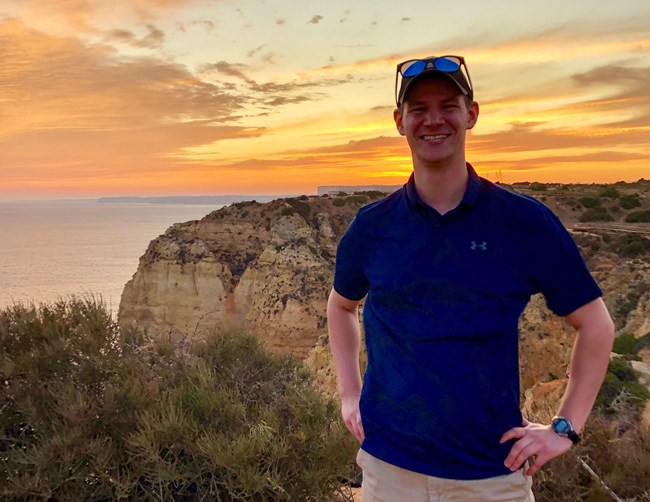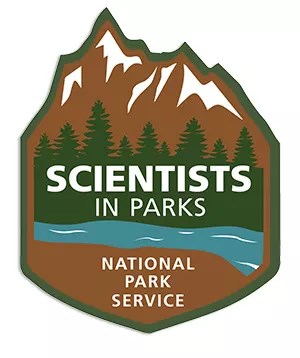Last updated: January 12, 2024
Article
The Oasis Newsletter: Fall 2021


NPS / Kimber Godfrey
White Nose Syndrome in Bats: "Inconclusive" Detection of Disease-causing Fungus in California and Arizona
With National Park Service Emerging Diseases funding, Alice Chung-MacCoubrey (Klamath Network Program Manager) and Allen Calvert (Mojave Desert Network Program Manager) have been leading surveillance in northern and southern California for white nose syndrome (Pseudogymnoascus destructans, or Pd). It primarily impacts bats during hibernation as it is a cold loving fungus that grows on bats' faces and wings, causing them to arouse from hibernation more frequently than normal to groom it off. This depletes their fat reserves, and they often don’t survive through to spring. In addition, the fungus can penetrate the skin on their wings and cause damage that can impact their ability to fly. This surveillance work led to the first “inconclusive” detection of Pd in California (2018). An increasing number of subsequent inconclusive detections followed in 2019 and 2021 at various sites in northern California. Inconclusive results were also recorded at Mojave Desert Network (MOJN) parks in southern California and northwestern Arizona for the first time this year. This was surprising, given the absence of any other known positive results from nearby areas, but it may mean the fungus has arrived in southern California. An inconclusive result means that the lab detected the presence of the fungus in samples, but the levels were too low to confirm the results. A press release provides more details.

NPS / Kimber Godfrey
Specifically at MOJN, a total of 126 bats were sampled across four parks — Death Valley National Park (DEVA), Mojave National Preserve (MOJA), Joshua Tree National Park (JOTR), and Grand Canyon-Parashant National Monument (PARA) this year. Unfortunately, no sampling was possible in Nevada parks due to a delay in allowing bat handling because of concerns about the possibility of transmitting COVID-19 to bats. One bat at DEVA and one bat at PARA and three bats each at MOJA and JOTR resulted in inconclusive results. Of the four species with inconclusive results, two had not previously been known to carry the fungus (California Myotis and the Canyon Bat). We received additional funds from the NPS Biological Resources Division that will allow us to greatly increase our sampling in 2022 to better determine whether the fungus has arrived in the Mojave Desert, and we plan to coordinate with others across the region. Detecting the fungus does not mean that the disease is present. We don’t yet know how/if this will impact bats in our area. Due to the difficulty in finding hibernation sites in the west, we will continue our acoustic surveys, which can help determine if a specific species is showing a decline in detections. Then we can assist with more targeted research to determine if a decline is because of WNS or some other threat.
You may learn more about the MOJN bat monitoring program by downloading a project brief. Additionally, the NPS Bats website has more information about bat status, threats, monitoring in parks and conservation.

NPS / Logan Combs
Aspen Protocol Updated and Implementation Begun at Great Basin National Park
Aspen are an important resource in two parks in the Mojave Desert Network (MOJN), occurring in both Great Basin National Park (GRBA) and Grand Canyon-Parashant National Monument (PARA). In addition to their spectacular annual fall display of golden leaves that draws visitors, they also provide habitat for wildlife and play an important role in the ecosystem. Aspen stands support a rich diversity of other plant and animal species, and where aspen stands have declined, researchers have also noted declines in other species in those habitats.
In September of 2021, after finalizing aspen monitoring protocol changes, MOJN field crews collected data for the first panel (or group) of aspen plots at Great Basin National Park. This panel included 54 plots covering three areas of the park – Baker Creek (n = 41), Lexington Creek (n = 6), and Decathon Canyon (n = 7). In 2019, pilot data were collected at PARA. To learn more about our aspen monitoring project, check out this new project overview brief.
Data Release Report
Bailard, J., Lehman, M, and Wright, S. 2021. Mojave Desert Network streams and lakes data package, 2009-2020. Data Release Report. IRMA. National Park Service, Boulder City, Nevada.
Recently, Jennifer Bailard, Physical Scientist, Mark Lehman, Data Manager, and Sarah Wright, Data Scientist, completed a data release report for the MOJN streams and lakes protocol. Why is this important? This report is a model for how MOJN will publish its Desert Springs and Selected Large Springs protocol discrete data in the future.
The data release comprises several CSV files containing raw and calculated discrete data for the MOJN Streams and Lake protocol. CSV (comma separated values) is a simple, widely used file format that is machine readable and requires no proprietary software.
The data release report includes an interactive R markdown HTML document that contains data quality control (QC) checks, data summaries, and data visualizations. All of the products in this data release were created using scripted code in the R statistical package, which will greatly improve the efficiency of creating future reports and also ensures that our data workflow is transparent and reproducible.
Recent Project Briefs
The following project summaries provide brief overviews of four monitoring projects, and highlights from the Bat Blitz event at Great Basin National Park.
October 2021 – March 2022 Field Schedule
| Protocol | Oct | Nov | Dec | Jan | Feb | Mar |
|---|---|---|---|---|---|---|
| Bats | – | – | – | Winter Acoustics: DEVA, GRBA, JOTR, LAKE, MOJA, PARA |
Winter Acoustics: DEVA, GRBA, JOTR, LAKE, MOJA, PARA |
Capture: DEVA, GRBA, JOTR, LAKE, MOJA, PARA |
| Desert Springs | LAKE | LAKE, DEVA | LAKE, JOTR | JOTR, MOJA | MOJA | MOJA, PARA |
| Selected Large Springs | – | – | JOTR, LAKE, MOJA, PARA |
– | – | Biennial Sampling: JOTR, LAKE, MOJA, PARA |
| Streams and Lakes | – | – | – | – | – | – |
| Aspen | – | – | – | – | – | – |
| Integrated Uplands | – | – | – | – | – | MOJA |
| Spring Vegetation | – | – | – | – | – | – |
| White Pine | – | – | – | – | – | – |

Second Science Symposium (First Virtual) A Success
While there was much enthusiasm to have an in-person science symposium again, the status of COVID-19 shifted us to our first virtual symposium instead on November 16-17, 2021. Our attendance peaked at 76 people and appeared to not drop lower than the mid-60s most of the time. Because Emailed invites were sent far and wide, it was hard to know how many different people attended over the two days. From our formal registration, we know that at least 12 government, academic, and private organizations participated.
A big shoutout to Kass Bissmeyer, Program Specialist with NPS Biological Resources Division – Natural Resources Stewardship and Science, for contributing so much expertise in virtual meeting planning and facilitation to our symposium planning team. She did a great job facilitating and helped us set up a SharePoint site where we could easily share the agenda, abstracts, speaker bios, and posters with Department of Interior (DOI) participants. See the word cloud for the one-word descriptions of how people felt about the symposium at the end.
To make a virtual meeting more palatable, we kept the time frame each day to four hours or less. The first day opened with a keynote address on the Resist-Accept-Direct decision support framework for resource managers, given by Jennifer Wilkening, Research Ecologist with the U.S. Fish and Wildlife Service, followed by a breakout session. Thirteen additional talks were presented by NPS, Bureau of Land Management, US Geological Survey, and university participants. NPS staff also contributed three posters.
Presentations were recorded, and DOI employees may access the recordings at our SharePoint site. Abstracts, speaker information, and posters are also shared there. For those outside of DOI, abstracts and the agenda are available here. While the virtual approach worked well, we do hope to be able to host an in-person event next time! Please contact Linda Mutch if you would like YouTube links to presentations.

Staffing Updates
Jeff Galvin
Mojave Desert Network welcomed our new Plant Ecologist, Jeff Galvin, in June! Jeff joined us after having spent nearly a decade working in the Sonoran Desert Network on vegetation monitoring projects as well as vegetation mapping and classification. He also has worked with other parks, agencies and organizations including Joshua Tree National Park, USGS, and the Western Riverside County Multiple Species Habitat Conservation Plan Biological Monitoring Program.
Jeff brings a wealth of experience into his new position, which involves heading up all the vegetation-related projects for MOJN, including monitoring five-needle pines, aspen, integrated uplands, spring vegetation, and invasive species early detection. He hit the ground running this summer with many weeks of field work, including the first season of implementing Aspen monitoring at Great Basin National Park. In his free time, Jeff enjoys his desert environs, rock climbing, botanizing, cooking, canyoneering, road biking, and kayaking.

Logan Combs
We said goodbye to Logan Combs in June, as he departed for a Hydrological Technician position with the USGS Nevada Water Science Center. Logan was a member of our MOJN team since 2017, working as a Physical Science Technician on all things aquatic. As field crew lead, Logan was talented at managing the logistics of our water resource monitoring. He also took charge of managing our continuous streams and lakes data and made huge progress working through years of backlog. He was always positive and willing to help out. We miss you Logan (and your SpongeBob memes), but we know you’re still in the area and expect to cross paths while out monitoring Mojave Desert water resources!

Vianey Murphey
Vianey Murphy joined MOJN for three months in May as our Conservation Legacy intern. Vianey, an Environmental and Resource Science major at Nevada State College (and Vegas Valley native), assisted the MOJN vegetation and hydrology teams with fieldwork in integrated upland and springs monitoring, respectively. She also helped with our bat monitoring program. Vianey completed her internship with MOJN in July and expects to finish her degree in December, with plans to pursue a career in in conservation biology. Best wishes, Vianey!

Jenelle Booker
We were pleased to host Jenelle Booker as our MOSAICS in Science intern in May through July. Jenelle’s primary focus was assisting with science communication, and in particular, with elevating MOJN’s social media presence. Jenelle has a B.A. in chemistry, and she is passionate about exploring how this knowledge can be employed to solve some of our current environmental problems, as evidenced by her senior thesis work which examined microbial analysis for rehabilitation after the BP oil spill. Jenelle left in August to return to The Wooster College in Ohio to complete her Environmental Studies and German minors and to continue as a Senior Researcher in the Faust environmental chemistry lab.

Kyle Smith
Kyle Smith returned in January 2021 for his second season with MOJN as a biological science technician. He assisted with all the vegetation protocols, including integrated uplands, pine, aspen, and spring vegetation monitoring. Kyle also helped the MOJN team with bat monitoring. Kyle’s season with MOJN ended in October, but we are delighted to announce that he has been hired as a career seasonal biological technician! He will return in January 2022 to work on MOJN vegetation projects through the spring and will also spend some of the summer assisting the Upper Columbia Basin Network on two shared protocols, aspen and white pine monitoring.

Evan Kolb
Before joining MOJN this fall to assist with water monitoring projects, Evan worked across several different disciplines. After college, he worked in Oklahoma City for an oil and gas company as a geoscientist. He then ventured off to Utah to work at Zion National Park as a hydrology assistant. There, he worked with a team to establish the Park's first comprehensive springs and seeps inventory. He is excited to join MOJN through the Scientists in Parks (SiP) Intern Program. Despite being new to the southwest, Evan loves the boundless recreational opportunities and sights it has to offer. Outside of work, he enjoys snowboarding, fly-fishing, backpacking, kayaking, and exploring the mountains. Welcome, Evan!

Emma Kaufman
Emma also joined MOJN in October as an intern through the SiP program. She will assist with desert springs monitoring and other water resources monitoring projects. She is a recent graduate of Brown University and brings her experience working in rainforests and a variety of other terrestrial and marine ecosystems, as well as environmental education. She looks forward to continuing to explore new environments at MOJN, while helping collect important aquatic data. When not working in the field, she enjoyes baking, hiking, rock climbing, and playing ultimate frisbee. Welcome, Emma!

Two New Scientists in Parks Positions Advertised
The Mojave Desert Network (MOJN) is advertising two new Scientists in Parks (SiP) positions for summer 2022. One has an emphasis on data management and data science for several MOJN monitoring projects. This Natural Resource Management Assistant will work closely with the network's Data Manager and Data Scientist. See this web page for a position description and link to apply.The second position will assist with field work for MOJN's vegetation monitoring projects in multiple MOJN national parks. This Ecology Assistant will work with the network's Plant Ecologist, Biological Science Technicians, and monitoring crew members. Go to this web page for the position description and to apply. Learn more about the Scientists in Parks program here.
